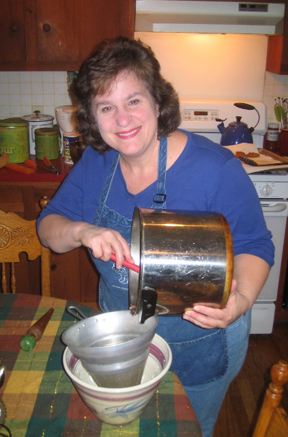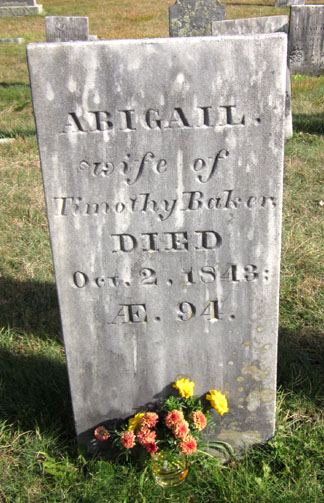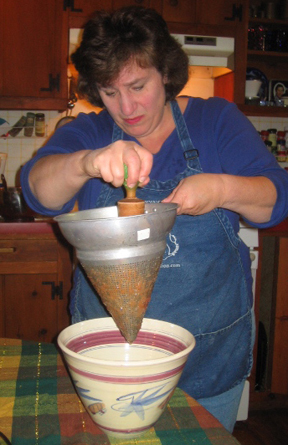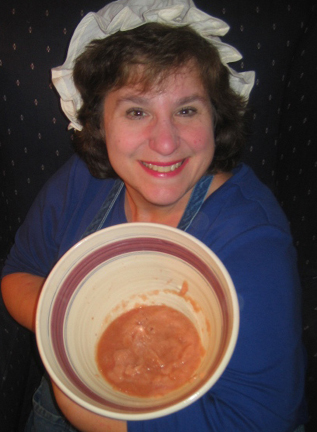
Today I’m doing something I’ve never done before, revising an old post. I have quite a few apples on hand (although not as many as I did two years ago, when I originally posted this recipe). So I’m returning to the recipe myself and thought readers might like to come along.
When I first posted it, I didn’t have any regular readers—so I don’t know how many of you, if any, have looked at it.
Here are my words (slightly edited) from October 2008:
This year has seen the most abundant apple harvest I can recall in our corner of New England. My neighbor Alice speculates that our literal windfall of apples has something to do with the hatching of swarms of bees just as the apple trees blossomed last spring.
All I know is that our apple trees, most of which are older than anyone living on our road, suddenly acted like fertile teenagers.
Naturally, my mother and I have made large quantities of applesauce. Applesauce is the perfect fall comfort food, and it’s amazingly easy to make, especially if you have a food mill. Food mills render the peeling and coring of apples completely unnecessary.
The skin, core, and seeds of the apple cook along with the sauce, adding flavor to the end product, and then get pushed out and discarded. The residue left in the food mill is surprisingly small.
If you don’t have a food mill, you will have to peel and core your apples. On the other hand, you will end up with lumpy applesauce, which some people prefer to the smoother version.
As you can see in the photographs above and below, my food mill requires me to push the apple pulp manually through the holes in the mill. My neighbor Peter has a relatively high-tech machine with a crank that does most of the work. Either type of mill is definitely worth purchasing.
My applesauce is named after Abigail Baker, who lived around the corner from our property in Hawley, Massachusetts, in the 18th and early 19th centuries. Mrs. Baker is famous (in our corner of the world, at any rate) for creating the winning pudding in a late 18th-century pudding contest that gave our district, Pudding Hollow, its name.

When my friend Judith Russell and I began work on our Pudding Hollow Cookbook, Judy suggested that we include a recipe for Mrs. Baker’s applesauce. Somehow it slipped through the cracks then so I’m rectifying that omission here on my blog.
I have portrayed Mrs. Baker several times in the entertainment that accompanies our revived pudding contest. And I see her grave every time I visit my what my nephew Michael calls my father’s “burial crypt” in the Pudding Hollow Cemetery. Hawley’s most celebrated cook is therefore seldom out of my thoughts.
Judy, too, is in my thoughts a lot, especially at this time of year. She died in the autumn of 1994, but her colorful folk art and sunny spirit live on in our hills, in our hearts, and in my cookbook.

Ingredients:
enough apples to make 6 generous cups of cut-up apples (preferably more than 1 variety)
1 cinnamon stick
1 pinch salt
1/4 cup cider plus additional cider as needed
maple syrup to taste, depending on the tartness of your apples (I used 2 tablespoons for the batch pictured here, which was relatively sweet)
Instructions:
Wash the apples and quarter them (actually, I tend to cut them into eighths if they are at all big). Remove any bad spots, but don’t worry about cutting out the core and seeds if you have a food mill.
Place the apple pieces, the cinnamon stick, the salt, and the cider in a 4-quart pot. Bring the mixture to a simmer over low heat, covered, and simmer it until the apples soften, checking frequently to see whether you need to add more cider to keep the sauce from burning. The cooking time will depend on the type and age of your apples and how many of them you are using. A 6-cup batch may take as little as 25 minutes, but a larger, firmer batch can take up to an hour.
Let the apples cool for a few minutes; then run them through a food mill. Discard the pulp and seeds (excellent pig food or compost!), and place the sauce in a saucepan. Add maple syrup to taste, and heat until the syrup dissolves, stirring to keep the syrup from burning.
If you want to can your sauce, reheat it to the boiling point, ladle it into sterilized jars, and process pint jars in a boiling-water bath for 20 minutes.
The yield will depend on your apples. Six generous cups of apple pieces provide about 1 pint of sauce. Feel free to multiply this recipe if your apple harvest is copious.











